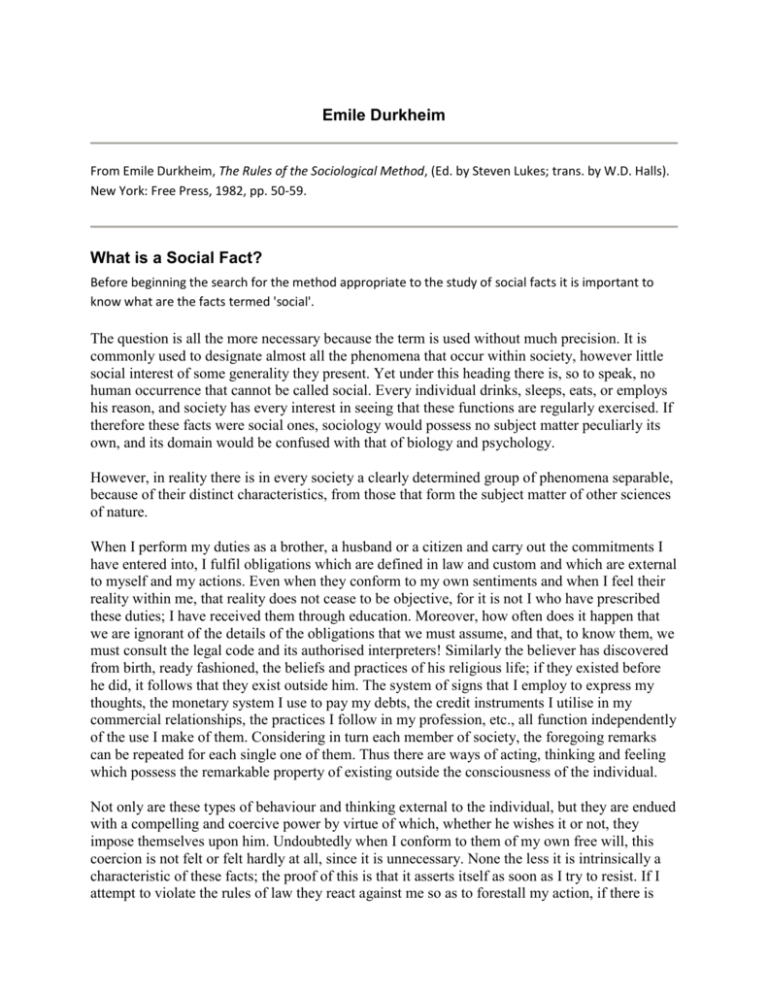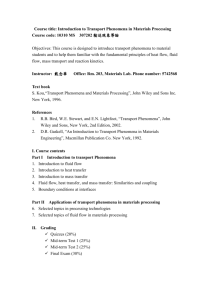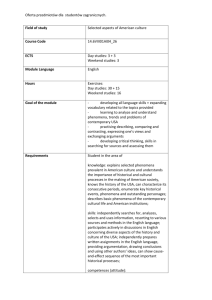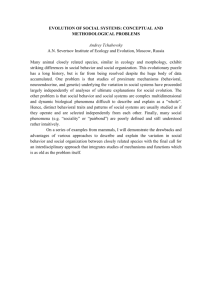DurkheimWhatIsAsocialFACT
advertisement

Emile Durkheim From Emile Durkheim, The Rules of the Sociological Method, (Ed. by Steven Lukes; trans. by W.D. Halls). New York: Free Press, 1982, pp. 50-59. What is a Social Fact? Before beginning the search for the method appropriate to the study of social facts it is important to know what are the facts termed 'social'. The question is all the more necessary because the term is used without much precision. It is commonly used to designate almost all the phenomena that occur within society, however little social interest of some generality they present. Yet under this heading there is, so to speak, no human occurrence that cannot be called social. Every individual drinks, sleeps, eats, or employs his reason, and society has every interest in seeing that these functions are regularly exercised. If therefore these facts were social ones, sociology would possess no subject matter peculiarly its own, and its domain would be confused with that of biology and psychology. However, in reality there is in every society a clearly determined group of phenomena separable, because of their distinct characteristics, from those that form the subject matter of other sciences of nature. When I perform my duties as a brother, a husband or a citizen and carry out the commitments I have entered into, I fulfil obligations which are defined in law and custom and which are external to myself and my actions. Even when they conform to my own sentiments and when I feel their reality within me, that reality does not cease to be objective, for it is not I who have prescribed these duties; I have received them through education. Moreover, how often does it happen that we are ignorant of the details of the obligations that we must assume, and that, to know them, we must consult the legal code and its authorised interpreters! Similarly the believer has discovered from birth, ready fashioned, the beliefs and practices of his religious life; if they existed before he did, it follows that they exist outside him. The system of signs that I employ to express my thoughts, the monetary system I use to pay my debts, the credit instruments I utilise in my commercial relationships, the practices I follow in my profession, etc., all function independently of the use I make of them. Considering in turn each member of society, the foregoing remarks can be repeated for each single one of them. Thus there are ways of acting, thinking and feeling which possess the remarkable property of existing outside the consciousness of the individual. Not only are these types of behaviour and thinking external to the individual, but they are endued with a compelling and coercive power by virtue of which, whether he wishes it or not, they impose themselves upon him. Undoubtedly when I conform to them of my own free will, this coercion is not felt or felt hardly at all, since it is unnecessary. None the less it is intrinsically a characteristic of these facts; the proof of this is that it asserts itself as soon as I try to resist. If I attempt to violate the rules of law they react against me so as to forestall my action, if there is still time. Alternatively, they annul it or make my action conform to the norm if it is already accomplished but capable of being reversed; or they cause me to pay the penalty for it if it is irreparable. If purely moral rules are at stake, the public conscience restricts any act which infringes them by the surveillance it exercises over the conduct of citizens and by the special punishments it has at its disposal. In other cases the constraint is less violent; nevertheless, it does not cease to exist. If I do not conform to ordinary conventions, if in my mode of dress I pay no heed to what is customary in my country and in my social class, the laughter I provoke, the social distance at which I am kept, produce, although in a more mitigated form, the same results as any real penalty. In other cases, although it may be indirect, constraint is no less effective. I am not forced to speak French with my compatriots, nor to use the legal currency, but it is impossible for me to do otherwise. If I tried to escape the necessity, my attempt would fail miserably. As an industrialist nothing prevents me from working with the processes and methods of the previous century, but if I do I will most certainly ruin myself. Even when in fact I can struggle free from these rules and successfully break them, it is never without being forced to fight against them. Even if in the end they are overcome, they make their constraining power sufficiently felt in the resistance that they afford. There is no innovator, even a fortunate one, whose ventures do not encounter opposition of this kind. Here, then, is a category of facts which present very special characteristics: they consist of manners of acting, thinking and feeling external to the individual, which are invested with a coercive power by virtue of which they exercise control over him. Consequently, since they consist of representations and actions, they cannot be confused with organic phenomena, nor with psychical phenomena, which have no existence save in and through the individual consciousness. Thus they constitute a new species and to them must be exclusively assigned the term social. It is appropriate, since it is clear that, not having the individual as their substratum, they can have none other than society, either political society in its entirety or one of the partial groups that it includes - religious denominations, political and literary schools, occupational corporations, etc. Moreover, it is for such as these alone that the term is fitting, for the word 'social' has the sole meaning of designating those phenomena which fall into none of the categories of facts already constituted and labelled. They are consequently the proper field of sociology. It is true that this word 'constraint', in terms of which we define them, is in danger of infuriating those who zealously uphold out-and-out individualism. Since they maintain that the individual is completely autonomous, it seems to them that he is diminished every time he is made aware that he is not dependent on himself alone. Yet since it is indisputable today that most of our ideas and tendencies are not developed by ourselves, but come to us from outside, they can only penetrate us by imposing themselves upon us. This is all that our definition implies. Moreover, we know that all social constraints do not necessarily exclude the individual personality. [1] Yet since the examples just cited (legal and moral rules, religious dogmas, financial systems, etc.) consist wholly of beliefs and practices already well established, in view of what has been said it might be maintained that no social fact can exist except where there is a well defined social organisation. But there are other facts which do not present themselves in this already crystallised form but which also possess the same objectivity and ascendancy over the individual. These are what are called social 'currents'. Thus in a public gathering the great waves of enthusiasm, indignation and pity that are produced have their seat in no one individual consciousness. They come to each one of us from outside and can sweep us along in spite of ourselves. If perhaps I abandon myself to them I may not be conscious of the pressure that they are exerting upon me, but that pressure makes its presence felt immediately I attempt to struggle against them. If an individual tries to pit himself against one of these collective manifestations, the sentiments that he is rejecting will be turned against him. Now if this external coercive power asserts itself so acutely in cases of resistance, it must be because it exists in the other instances cited above without our being conscious of it. Hence we are the victims of an illusion which leads us to believe we have ourselves produced what has been imposed upon us externally. But if the willingness with which we let ourselves be carried along disguises the pressure we have undergone, it does not eradicate it. Thus air does not cease to have weight, although we no longer feel that weight. Even when we have individually and spontaneously shared in the common emotion, the impression we have experienced is utterly different from what we would have felt if we had been alone. Once the assembly has broken up and these social influences have ceased to act upon us, and we are once more on our own, the emotions we have felt seem an alien phenomenon, one in which we no longer recognise ourselves. It is then we perceive that we have undergone the emotions much more than generated them. These emotions may even perhaps fill us with horror, so much do they go against the grain. Thus individuals who are normally perfectly harmless may, when gathered together in a crowd, let themselves be drawn into acts of atrocity. And what we assert about these transitory outbreaks likewise applies to those more lasting movements of opinion which relate to religious, political, literary and artistic matters, etc., and which are constantly being produced around us, whether throughout society or in a more limited sphere. Moreover, this definition of a social fact can be verified by examining an experience that is characteristic. It is sufficient to observe how children are brought up. If one views the facts as they are and indeed as they have always been, it is patently obvious that all education consists of a continual effort to impose upon the child ways of seeing, thinking and acting which he himself would not have arrived at spontaneously. From his earliest years we oblige him to eat, drink and sleep at regular hours, and to observe cleanliness, calm and obedience; later we force him to learn how to be mindful of others, to respect customs and conventions, and to work, etc. If this constraint in time ceases to be felt it is because it gradually gives rise to habits, to inner tendencies which render it superfluous; but they supplant the constraint only because they are derived from it. It is true that, in Spencer's view, a rational education should shun such means and allow the child complete freedom to do what he will. Yet as this educational theory has never been put into practice among any known people, it can only be the personal expression of a desideratum and not a fact which can be established in contradiction to the other facts given above. What renders these latter facts particularly illuminating is that education sets out precisely with the object of creating a social being. Thus there can be seen, as in an abbreviated form, how the social being has been fashioned historically. The pressure to which the child is subjected unremittingly is the same pressure of the social environment which seeks to shape him in its own image, and in which parents and teachers are only the representatives and intermediaries. Thus it is not the fact that they are general which can serve to characterise sociological phenomena. Thoughts to be found in the consciousness of each individual and movements which are repeated by all individuals are not for this reason social facts. If some have been content with using this characteristic in order to define them it is because they have been confused, wrongly, with what might be termed their individual incarnations. What constitutes social facts are the beliefs, tendencies and practices of the group taken collectively. But the forms that these collective states may assume when they are 'refracted' through individuals are things of a different kind. What irrefutably demonstrates this duality of kind is that these two categories of facts frequently are manifested dissociated from each other. Indeed some of these ways of acting or thinking acquire, by dint of repetition, a sort of consistency which, so to speak, separates them out, isolating them from the particular events which reflect them. Thus they assume a shape, a tangible form peculiar to them and constitute a reality sui generis vastly distinct from the individual facts which manifest that reality. Collective custom does not exist only in a state of immanence in the successive actions which it determines, but, by a privilege without example in the biological kingdom, expresses itself once and for all in a formula repeated by word of mouth, transmitted by education and even enshrined in the written word. Such are the origins and nature of legal and moral rules, aphorisms and popular sayings, articles of faith in which religious or political sects epitomise their beliefs, and standards of taste drawn up by literary schools, etc. None of these modes of acting and thinking are to be found wholly in the application made of them by individuals, since they can even exist without being applied at the time. Undoubtedly this state of dissociation does not always present itself with equal distinctiveness. It is sufficient for dissociation to exist unquestionably in the numerous important instances cited, for us to prove that the social fact exists separately from its individual effects. Moreover, even when the dissociation is not immediately observable, it can often be made so with the help of certain methodological devices. Indeed it is essential to embark on such procedures if one wishes to refine out the social fact from any amalgam and so observe it in its pure state. Thus certain currents of opinion, whose intensity varies according to the time and country in which they occur, impel us, for example, towards marriage or suicide, towards higher or lower birth-rates, etc. Such currents are plainly social facts. At first sight they seem inseparable from the forms they assume in individual cases. But statistics afford us a means of isolating them. They are indeed not inaccurately represented by rates of births, marriages and suicides, that is, by the result obtained after dividing the average annual total of marriages, births, and voluntary homicides by the number of persons of an age to marry, produce children, or commit suicide. [2] Since each one of these statistics includes without distinction all individual cases, the individual circumstances which may have played some part in producing the phenomenon cancel each other out and consequently do not contribute to determining the nature of the phenomenon. What it expresses is a certain state of the collective mind. That is what social phenomena are when stripped of all extraneous elements. As regards their private manifestations, these do indeed having something social about them, since in part they reproduce the collective model. But to a large extent each one depends also upon the psychical and organic constitution of the individual, and on the particular circumstances in which he is placed. Therefore they are not phenomena which are in the strict sense sociological. They depend on both domains at the same time, and could be termed socio-psychical. They are of interest to the sociologist without constituting the immediate content of sociology. The same characteristic is to be found in the organisms of those mixed phenomena of nature studied in the combined sciences such as biochemistry. It may be objected that a phenomenon can only be collective if it is common to all the members of society, or at the very least to a majority, and consequently, if it is general. This is doubtless the case, but if it is general it is because it is collective (that is, more or less obligatory); but it is very far from being collective because it is general. It is a condition of the group repeated in individuals because it imposes itself upon them. It is in each part because it is in the whole, but far from being in the whole because it is in the parts. This is supremely evident in those beliefs and practices which are handed down to us ready fashioned by previous generations. We accept and adopt them because, since they are the work of the collectivity and one that is centuries old, they are invested with a special authority that our education has taught us to recognise and respect. It is worthy of note that the vast majority of social phenomena come to us in this way. But even when the social fact is partly due to our direct co-operation, it is no different in nature. An outburst of collective emotion in a gathering does not merely express the sum total of what individual feelings share in common, but is something of a very different order, as we have demonstrated. It is a product of shared existence, of actions and reactions called into play between the consciousnesses of individuals. If it is echoed in each one of them it is precisely by virtue of the special energy derived from its collective origins. If all hearts beat in unison, this is not as a consequence of a spontaneous, preestablished harmony; it is because one and the same force is propelling them in the same direction. Each one is borne along by the rest. We have therefore succeeded in delineating for ourselves the exact field of sociology. It embraces one single, well defined group of phenomena. A social fact is identifiable through the power of external coercion which it exerts or is capable of exerting upon individuals. The presence of this power is in turn recognisable because of the existence of some pre-determined sanction, or through the resistance that the fact opposes to any individual action that may threaten it. However, it can also be defined by ascertaining how widespread it is within the group, provided that, as noted above, one is careful to add a second essential characteristic; this is, that it exists independently of the particular forms that it may assume in the process of spreading itself within the group. In certain cases this latter criterion can even be more easily applied than the former one. The presence of constraint is easily ascertainable when it is manifested externally through some direct reaction of society, as in the case of law, morality, beliefs, customs and even fashions. But when constraint is merely indirect, as with that exerted by an economic organization, it is not always so clearly discernible. Generality combined with objectivity may then be easier to establish. Moreover, this second definition is simply another formulation of the first one: if a mode of behaviour existing outside the consciousnesses of individuals becomes general, it can only do so by exerting pressure upon them. [3] However, one may well ask whether this definition is complete. Indeed the facts which have provided us with its basis are all ways of functioning: they are 'physiological' in nature. But there are also collective ways of being, namely, social facts of an 'anatomical' or morphological nature. Sociology cannot dissociate itself from what concerns the substratum of collective life. Yet the number and nature of the elementary parts which constitute society, the way in which they are articulated, the degree of coalescence they have attained, the distribution of population over the earth's surface, the extent and nature of the network of communications, the design of dwellings, etc., do not at first sight seem relatable to ways of acting, feeling or thinking. Yet, first and foremost, these various phenomena present the same characteristic which has served us in defining the others. These ways of being impose themselves upon the individual just as do the ways of acting we have dealt with. In fact, when we wish to learn how a society is divided up politically, in what its divisions consist and the degree of solidarity that exists between them, it is not through physical inspection and geographical observation that we may come to find this out: such divisions are social, although they may have some physical basis. It is only through public law that we can study such political organisation, because this law is what determines its nature, just as it determines our domestic and civic relationships. The organisation is no less a form of compulsion. If the population clusters together in our cities instead of being scattered over the rural areas, it is because there exists a trend of opinion, a collective drive which imposes this concentration upon individuals. We can no more choose the design of our houses than the cut of our clothes - at least, the one is as much obligatory as the other. The communication network forcibly prescribes the direction of internal migrations or commercial exchanges, etc., and even their intensity. Consequently, at the most there are grounds for adding one further category to the list of phenomena already enumerated as bearing the distinctive stamp of a social fact. But as that enumeration was in no wise strictly exhaustive, this addition would not be indispensable. Moreover, it does not even serve a purpose, for these ways of being are only ways of acting that have been consolidated. A society's political structure is only the way in which its various component segments have become accustomed to living with each other. If relationships between them are traditionally close, the segments tend to merge together; if the contrary, they tend to remain distinct. The type of dwelling imposed upon us is merely the way in which everyone around us and, in part, previous generations, have customarily built their houses. The communication network is only the channel which has been cut by the regular current of commerce and migrations, etc., flowing in the same direction. Doubtless if phenomena of a morphological kind were the only ones that displayed this rigidity, it might be thought that they constituted a separate species. But a legal rule is no less permanent an arrangement than an architectural style, and yet it is a 'physiological' fact. A simple moral maxim is certainly more malleable, yet it is cast in forms much more rigid than a mere professional custom or fashion. Thus there exists a whole range of gradations which, without any break in continuity, join the most clearly delineated structural facts to those free currents of social life which are not yet caught in any definite mould. This therefore signifies that the differences between them concern only the degree to which they have become consolidated. Both are forms of life at varying stages of crystallisation. It would undoubtedly be advantageous to reserve the term 'morphological' for those social facts which relate to the social substratum, but only on condition that one is aware that they are of the same nature as the others. Our definition will therefore subsume all that has to be defined it if states: A social fact is any way of acting, whether fixed or not, capable of exerting over the individual an external constraint; or: which is general over the whole of a given society whilst having an existence of its own, independent of its individual manifestations. [4] Notes 1. Moreover, this is not to say that all constraint is normal. We shall return to this point later. 2. Suicides do not occur at any age, nor do they occur at all ages of life with the same frequency. 3. It can be seen how far removed this definition of the social fact is from that which serves as the basis for the ingenious system of Tarde. We must first state that our research has nowhere led us to corroboration of the preponderant influence that Tarde attributes to imitation in the genesis of collective facts. Moreover, from this definition, which is not a theory but a mere resume of the immediate data observed, it seems clearly to follow that imitation does not always express, indeed never expresses, what is essential and characteristic in the social fact . Doubtless every social fact is imitated and has, as we have just shown, a tendency to become generalised, but this is because it is social, i.e. obligatory. Its capacity for expansion is not the cause but the consequence of its sociological character. If social facts were unique in bringing about this effect, imitation might serve, if not to explain them, at least to define them. But an individual state which impacts on others none the less remains individual. Moreover, one may speculate whether the term 'imitation' is indeed appropriate to designate a proliferation which occurs through some coercive influence. In such a single term very different phenomena, which need to be distinguished, are confused. 4. This close affinity of life and structure, organ and function, can be readily established in sociology because there exists between these two extremes a whole series of intermediate stages, immediately observable, which reveal the link between them. Biology lacks this methodological resource. But one may believe legitimately that sociological inductions on this subject are applicable to biology and that, in organisms as in societies, between these two categories of facts only differences in degree exist.








